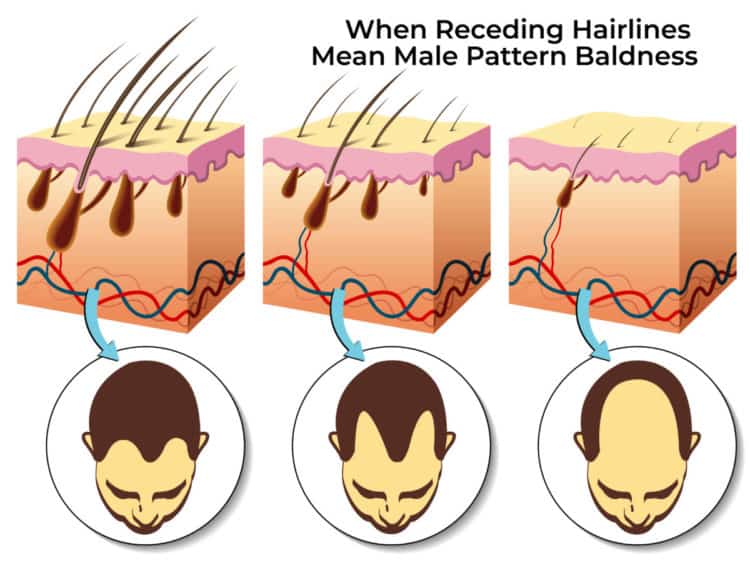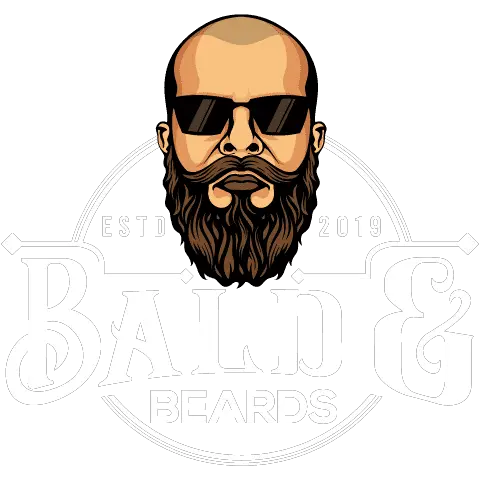No one has ever said, “Losing your hair is great,” so why do so many people wait to address hair loss and affect your hairline?
Receding hairline treatments focus on stopping hair loss and regrowing hair along the top of the forehead. It’s best to determine whether you have a mature hairline or a receding hairline due to male pattern hair loss before starting any treatments.
There are many treatments and ways to fix a receding hairline. If you catch hair loss early, you may be able to use one of these treatments to stop baldness in its tracks.
Receding Hairline Causes
The first step to treating a receding hairline is understanding the various causes. Talk to a dermatologist to learn about your unique situation and determine the right course of treatment.
Studying your hair in the mirror each morning won’t help a receding hairline. This only creates more stress, another reason hair falls out. The best way to treat a receding hairline is to pinpoint the cause and possibly changing your hair care routine.

Natural Shedding
Mature hairlines start to appear as men age, typically beginning in the late 20s. An average person loses about 100 hairs every day. Most of the time, this hair is replaced by new hair, but in some cases, hair follicles begin to die, creating more brittle hair that tends to break and eventually stops growing.
Genetic History
Male pattern baldness is typically hereditary. Men who have a history of androgenic alopecia would notice that other men in their family also have bald spots and receding hairlines.
Hormonal Changes
Testosterone and an abundance of DHT can lead to hair follicles struggling to produce new hair, and they may become blocked due to DHT. There are a variety of medications available to block DHT (dihydrotestosterone) and promote hair regrowth.
Dry Scalp and Dandruff
Itching at your scalp causes shedding and hair loss. Dry scalp, dandruff, and seborrheic dermatitis can cause buildup and lead to thinning hair and bald spots.
Bad Hair Products and Sensitivities
If you notice that your scalp is agitated or thinning more after a new product, you could have an allergy or sensitivity. Sulfates and PPDs (paraphenylenediamine) are often the culprits.
Age
As you grow older, hair loss is one of the main signs of aging. Men over the age of 35 may start to see an acceleration of hair loss.
To understand what type of hair loss you’re experiencing, you may need to undergo blood tests and see a dermatologist.

Most doctors will conduct a biopsy of scalp tissue to understand what’s going on with your hairline and what methods are available to treat it.
Regrow Your Receding Hairline
For some, regrowing a hairline is as simple as treating an underlying condition, such as dry scalp or dandruff. With male pattern baldness (androgenetic alopecia), hair restoration is necessary to reshape and regrow the hairline. However, these methods can be painful and expensive.
Mature vs Receding Hairline
Mature hairlines are different from receding hairlines as they change naturally. While you’ll start with a thick juvenile hairline, these change revealing different types of hairlines, like a Widow’s peak or uneven hairline. These are naturally maturing hairlines, rather than a receding hairline, where hair continues to thin until bald spots form.
If you’re experiencing hair thinning, some products like hair thinning shampoos or medicated creams can make help. Always see a doctor who’ll conduct tests for underlying medical conditions and prescribe the best treatment options.
Treatment Options
Can you stop a receding hairline? Experts recommend a few treatments available, including:
- hair loss shampoos
- biotin creams
- vitamin supplements
- saw palmetto
- changing your diet
- hair growth medications
However, many men seeking permanent hair regrowth opt for hair transplant surgery to re-create their hairlines.

Hair Loss Shampoos
When hair loss is caused by DHT, you may be able to reverse hair loss by using a medicated hair loss shampoo. These products are known to stop hair thinning, slow down hair loss, and stimulate regrowth.
Many shampoos are formulated to prevent dry scalp and dandruff promoting good hair health.
- Revita Hair Growth Stimulating Shampoo Ingredients include procyanidin B2, ketoconazole, niacinamide, and amino acids.
- Ultrax Labs Hair Surge Ingredients include ketoconazole, saw palmetto, and caffeine.
- PURA D’OR Ingredients include biotin, argan oil, nettle extract, saw palmetto, and red seaweed
To prevent a receding hairline, use hair loss shampoos 2 to 3 times per week and wait for at least 30 days to see growth.
See our full list of Hair Loss Shampoos.
Medications
A dermatologist may prescribe minoxidil or finasteride. These are the two most popular medical treatments for hair loss treatment. Studies have shown that both can be successful.
Minoxidil
Rogaine (Minoxidil) is what’s known as a vasodilator. It’s a topical cream, foam, or spray that you can apply to receding parts of your hairline to promote new hair growth.
Propecia
Finasteride (Propecia) is a DHT blocker that comes in pill form. It prevents your body from turning testosterone into DHT. This prevents the hormone from attaching to your hair follicles and causing distressing, leading to follicular death.
One 1998 finasteride study found it to slow hair loss plus successful at regrowing hair, increasing hair thickness and hair count in patients.
Laser Therapy
Low level laser hair therapy AKA red light therapy promotes hair growth by irradiating photons into the scalp. The weaker scalp cells absorb the photons to encourage new growth.
It’s become an acceptable practice that’s safe, and with no real side effects. It’s typically pain free and much less invasive over FUE or FUT transplant surgery (below).

Hair Transplant Surgery
A viable, long-term solution to a receding hairline includes hair transplant surgery. This process removes healthy follicles from other parts of your body, typically the back and sides of your head, and relocates those follicles to your hairline.

Newly transplanted follicles grow hair in specific spots, eventually leading to thicker, naturally looking hair.
There are some drawbacks to this surgery, such as transplant scars, recovery time, and pain. Not all procedures work and more hair may need to be transplanted again after a few years.
Biotin
One of the newer ways to regrow hair is through increasing biotin intake. While we naturally ingest biotin through red meat and leafy green vegetables, it’s possible that a biotin deficiency could lead to hair loss.
Biotin helps with keratin in your body, which is necessary for healthy hair growth.
A 2015 study showed that patients given a biotin pill every day for 90 days saw an increase in hair growth and thickness, as well as less shedding.
Supplements
With biotin supplements, you can intake 30 mcg per day as an adult to get started. Some men start to see hair growth in as little as 14 days, but others report waiting up to 3 months to notice hair regrowth.
Creams
Biotin creams and shampoos are also available. These try to sponsor hair growth by applying biotin directly to bald spots. These may not be as effective as ingesting biotin and improving your body’s keratin production.
Hairstyles for Receding Hairline
Just like wearing black hides a little extra weight, choosing the right haircut can help conceal your receding hair loss.
A good first step is to consult a modern barber to discuss how to make the most of what you have and suggest the best style. There are many haircuts that’ll compliment a receding hairline.
See more hairstyles for a receding hairline.
Not all men experience hair regrowth with these methods. Success depends on the cause of hair loss and how long you have been experiencing bald spots.


